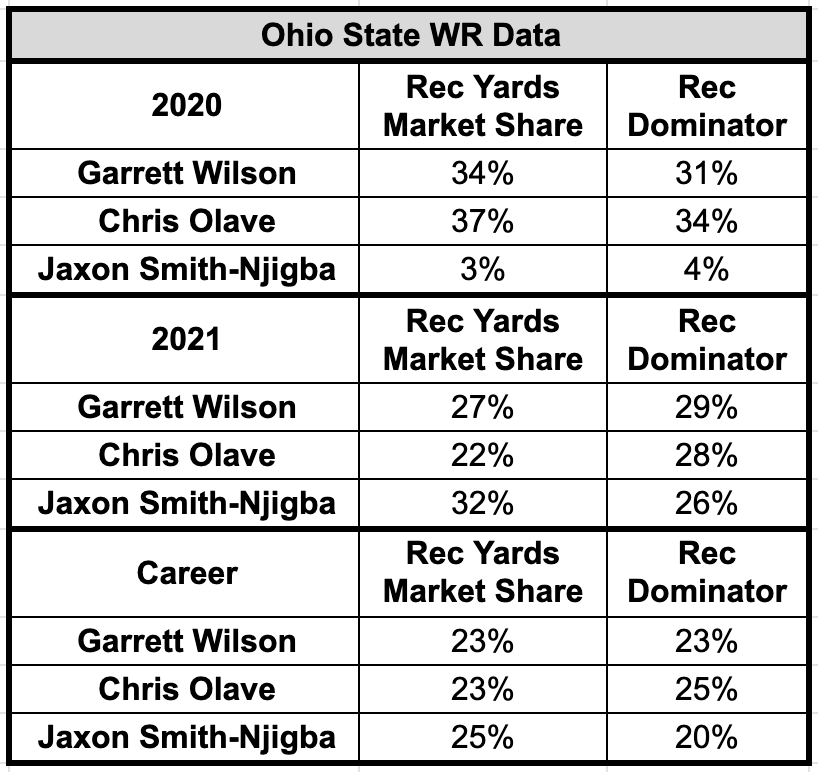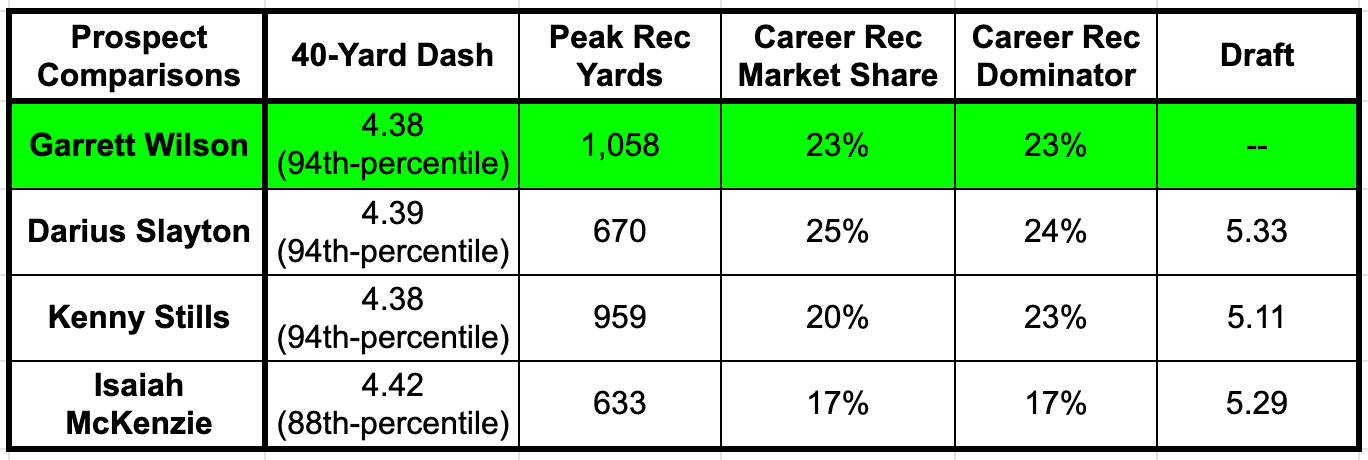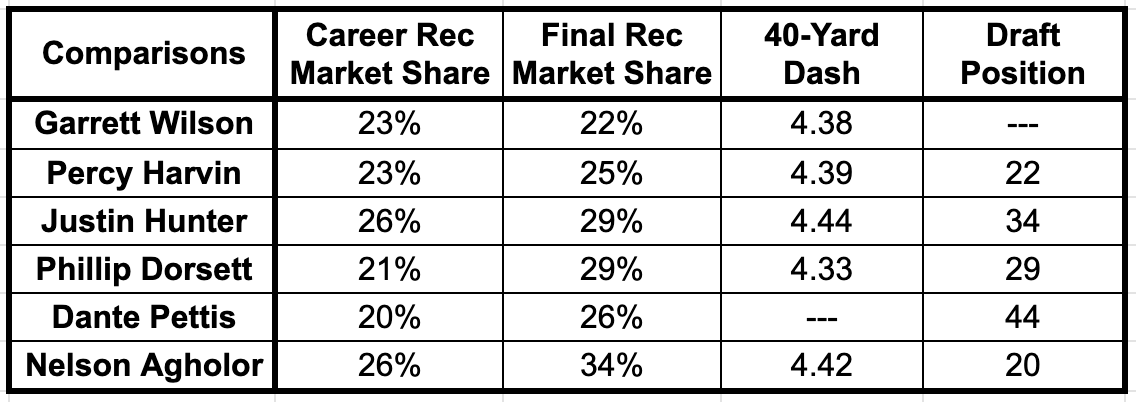Garrett Wilson NFL Draft
As a junior at Ohio State, Garrett Wilson peaked with over 1,000 receiving yards (1,058) in 11 games. Wilson posted a 20.1 (59th-percentile) Breakout Age during his sophomore season, with 723 receiving yards on 43 receptions and six touchdowns in 2020. Wilson suffered a concussion that caused him to miss time in 2021 and then opted out of the Rose Bowl.
Most TDs by a Big 10 WR since 2019:
1️⃣ Chris Olave – 32
2️⃣ Jahan Dotson – 25
3️⃣ Garrett Wilson – 23 pic.twitter.com/h7x2FwHAti— PFF Draft (@PFF_College) April 1, 2022
It’s unfair that Ohio State remains stacked with talent like many other top college football programs, evidenced by Justin Fields, Trey Sermon, and TreVeon Henderson over the past two seasons. Amongst receivers, Garrett Wilson battled with Jaxon Smith-Njigba and Chris Olave in 2021. Smith-Njigba smashed in 2021 to lead all Buckeye receivers with 95 receptions and 1,606 receiving, yet Wilson bested him in touchdowns with nine for Smith-Njigba. That said, let’s dive into the workout metrics.
NFL Workout Metrics
At 6-foot and 183-pounds, Wilson ran a 4.38 (94th-percentile) 40-yard dash that translated into a 98.1 (65th-percentile) Speed Score. Although speed isn’t the only important factor for receivers, Wilson comes in as a smaller receiver with straight-line speed. Wilson’s mediocre broad jump (55th-percentile) and below-average vertical jump (28th-percentile) led to a mediocre 122.7 (58th-percentile) Burst Score. Again, athletic measures don’t paint the whole picture for receivers.
Throughout Wilson’s college career, he posted a 26.3% (78th-percentile) target share and a 29.4% (50th-percentile) College Dominator. However, since Wilson shared opportunities with Smith-Njigba and Olave, it makes sense that Wilson’s Dominator Rating isn’t higher.
Wilson peaked in 2021 with a 27% receiving market share versus 32% for Smith-Njigba and 22% for Olave. However, Olave bested the trio with a peak 37% market share in 2020. Remember that the 2020 college season remained wacky with only eight games for Ohio State, with Wilson close behind at 34% in 2020. In the small sample of 2020 and 2021, Wilson appears like the most consistent Buckeye receiver via the production metrics.
Wilson’s Strengths
Garrett Wilson’s strengths include his speed and potential play-making ability. Although they’re not the most optimistic comparisons, Darius Slayton, Kenny Stills, and Isaiah McKenzie pop up based on the 40-yard dash and college production using the RotoViz Box Score Scouting Tool.
Although Slayton possessed similar receiving market shares, he peaked at 643 and 670 receiving yards in 2017 and 2018 on a run-focused offense at Auburn. Slayton also received fifth-round draft capital versus Wilson’s projected as a first-rounder in Jake Oliver’s recent NFL Mock Draft.
Stills also got drafted in the fifth round with a 4.38 (94th-percentile) 40-yard dash that peaked in 2012 with 959 receiving yards at Oklahoma. That season, the Sooners spread the ball around with Landry Jones at quarterback amongst Justin Brown and Sterling Shepard. Although McKenzie possessed speed and agility, evidenced by the 4.42 (88th-percentile) 40-yard dash and 10.79 (92nd-percentile) Agility Score), he also lacked the college production and draft capital (fifth round). Wilson produced and showed the ability to run various routes in the short, middle, and deep areas of the field on film.
Wilson’s Weaknesses
Although it’s not a confident weakness, Garrett Wilson didn’t dominate the production metrics like teammate Jaxon Smith-Njigba. However, Wilson showed some consistency and growth in his final two college seasons. Wilson also doesn’t stand out in Breakout Age, which we pay attention to with receivers.
Like the workout metrics, Breakout Age is only a piece of the puzzle, with A.J. Green, Golden Tate, Mike Wallace, and A.J. Brown having similar ages. Regardless, Wilson comes out as a junior with projected first-round draft capital, which means he’s likely an early dynasty rookie pick.
Another concern involves the potential landing spot with the Washington Commanders or the New York Jets. In 2021, Washington ranked 24th with 32.5 Team Pass Plays Per Game, and New York ranked 16th with 35.5 per game. Zach Wilson averaged 4.7 (No. 34) Adjusted Yards Per Attempt with a -11.3 (No. 29) Production Premium. Carson Wentz played on a different offense, but the efficiency looked mediocre, evidenced by the 6.9 (No. 13) Adjusted YPA and a -4.6 (No. 24) Production Premium. Overall, we’re nitpicking on Wilson’s weaknesses, meaning he has more positives than negatives in the prospect profile.
Wilson’s Player Comparisons
As noted earlier, Garrett Wilson compared similarly to Darius Slayton, Kenny Stills, and Isaiah McKenzie, given the college production and speed. Another similar player, assuming the first-round draft capital, involves Jerry Jeudy, who didn’t dominate in college yet displayed the upside on film.
Other notable comparisons with first-round draft capital include Percy Harvin, Phillip Dorsett, and Nelson Agholor. Justin Hunter and Dante Pettis went in the second round yet had similar production and speed. Dorsett, Pettis, Dorsett, and Hunter lacked the expected impact. However, Harvin flashed in his first three years in the NFL, given the all-around profile in the rushing, receiving, and special teams realm. Agholor’s career path looks rocky, but he provided WR2 or WR3 production in three of his seven seasons.
The Best Fit For Garrett Wilson
Assuming the landing spot of the Jets or Commanders as an early first-round pick, Garrett Wilson would serve as the second option at receiver. Wilson might be the third option in the receiving game if the team spreads out the passing opportunities. In 2021, the Jets evenly distributed the target share to Elijah Moore (19%), Jamison Crowder (17%), and Corey Davis (18%). Meanwhile, their top two backs garnered double-digit target shares, with Ty Johnson at 10% and Michael Carter at 11%.
With the Commanders, Terry McLaurin led the team with a 24% target share, almost ten percent more than J.D. McKissic (15%). Logan Thomas (13%) and Adam Humphries (12%) led the non-running backs, with Antonio Gibson at 10% and Ricky Seals-Jones at 11%. Garrett Wilson likely won’t have a target share above 20% unless the passing volume increases on either team. If the Steelers, Panthers, Seahawks, Giants, or Falcons snagged Wilson before the Commanders or Jets, the opportunity and efficiency scenario remains the same.
Overall, Wilson probably fits best as a second option with the potential to finish as a WR3 or WR4 in redraft leagues. Regardless, Wilson possesses the breakaway speed and play-making ability at various positions on the field to splash in Year 1. Based on Wilson’s talent, he should garner a healthy 18-20% target share as a rookie.



